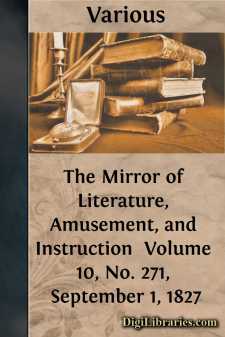Categories
- Antiques & Collectibles 13
- Architecture 36
- Art 48
- Bibles 22
- Biography & Autobiography 813
- Body, Mind & Spirit 142
- Business & Economics 28
- Children's Books 14
- Children's Fiction 11
- Computers 4
- Cooking 94
- Crafts & Hobbies 4
- Drama 346
- Education 46
- Family & Relationships 57
- Fiction 11829
- Games 19
- Gardening 17
- Health & Fitness 34
- History 1377
- House & Home 1
- Humor 147
- Juvenile Fiction 1873
- Juvenile Nonfiction 202
- Language Arts & Disciplines 88
- Law 16
- Literary Collections 686
- Literary Criticism 179
- Mathematics 13
- Medical 41
- Music 40
- Nature 179
- Non-Classifiable 1768
- Performing Arts 7
- Periodicals 1453
- Philosophy 64
- Photography 2
- Poetry 896
- Political Science 203
- Psychology 42
- Reference 154
- Religion 513
- Science 126
- Self-Help 84
- Social Science 81
- Sports & Recreation 34
- Study Aids 3
- Technology & Engineering 59
- Transportation 23
- Travel 463
- True Crime 29
The Mirror of Literature, Amusement, and Instruction Volume 10, No. 271, September 1, 1827
by: Various
Categories:
Description:
Excerpt
The New Prison, Norwich.
The old gaol in the city of Norwich, in the year 1823, being found no longer secure, nor according to the new act of parliament, admitting of sufficient room for the classification of the prisoners, the magistrates came to a resolution of erecting a new one outside the city, near St. Giles's gates; the same was accordingly advertised in the Norwich papers, in which architects were requested to send plans, elevations, and sections, (in competition,) accompanied with an estimate of the total expense of the new building. A great number of designs were in consequence submitted, when the plan sent by Mr. Brown, of Wells-street, Oxford-street, London, was adjudged to be the best: his plan was therefore adopted and carried into execution, of which the annexed engraving is a faithful representation, taken from the tower of St. Giles's Church, in the city of Norwich. The foundation stone was laid in 1824, and the building finished this year, 1827. It is designed to hold 120 prisoners, besides the necessary turnkeys and servants, and has cost the city £23,000; the boundary wall is quadrangular, but is cut off at the junction of the four angles by bastions, thereby giving to the wall a greater stability; the whole circumference is 1,220 feet, and encloses an area of one acre, two roods, and thirty-four poles, being nearly one acre and three quarters of ground.
The bastion at the entrance contains on the ground floor a porter's room, press room, hot and cold baths, and a room with an oven for the purpose of purifying foul linen. The upper story contains over the entrance gate the drop room: on each side are receiving cells, two for males and two for females, a searching room for the surgeon, and the prison wardrobe; directly over the drop room on the lead flat is the place where the more heinous malefactors expiate their crimes. The bastion on the right hand contains a building, on the ground floor and in the centre of which is the wash-house and laundry, and in front the drying ground; at each end of this building are the airing grounds for the sick prisoners, and on the second floor are the male and female infirmaries, separated by a strong partition wall. The left hand bastion contains the millhouse, stable, and a room for the van which takes the prisoners to the town hall in the assize time; over these three rooms are the mill chamber and hay-loft. The horizontal wind vane on the roof of this building is to assist the prisoners when there is not a sufficiency of them sentenced to the tread-wheels; by shutting the louvre boards of the arms it then produces employment for the prisoners when there is no corn in the mill to grind. In the remote bastion are seen the tread-wheels on which the prisoners are employed in keeping up a constant retrograde motion, which works the machinery in the millhouse by means of an iron shaft with universal joints concealed below the surface of the ground.
Here are four prison wings in the building, the right hand one contains in one ward common debtors, and in the other unconvicted men felons, not capital....












